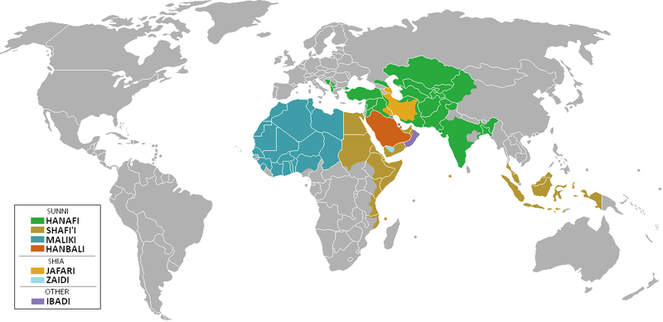This is Alex's Sunni page
Click on any text to edit. Simply drag and drop to use any of the tools above.
Sunni Muslims
Sunni is a sub-group of Islamic people and make up the majority of Islams. They make up a branch of the Muslim population. Their roots are traced back to the time of the prophet Mohammed in 7th century C.E.
The word 'Sunni' comes from a term that means they base their religion on the teachings of Mohammed.
All Muslims are split into two major groups, each with smaller sub-groups. They are the Sunni, and the Shi'a.
The word 'Sunni' comes from a term that means they base their religion on the teachings of Mohammed.
All Muslims are split into two major groups, each with smaller sub-groups. They are the Sunni, and the Shi'a.
Origins
Before Mohammed’s death in 632 C.E., the Sunni, and the Shi’a were one group. The divide took place due to the disagreement on who should become the new leader now that Mohammed has passed on. The Shi’a believed that his son-in-law should take over as leader, but the Sunni’s believed that the choice should be up to the community. This conflict split the Islam’s into the two modern groups we have today.
The fighting that currently plagues the two groups of Muslims started as early as 656 C.E. when the third successor as leader of the community of Quraysh was murdered. The fourth successor, Ali, cousin and son-in-law of Mohammed, took over and was lax in his pursuit of the murderers of Uthman ibn Affan, the 3rd successor. Since the first three successors were companions of Mohammed, rather than direct relatives, Sunni’s, especially Uthman supporters, accused Ali of being too easy going on the hunt for Uthman’s murderers. This eventually escalated to the First Civil War.
The fighting that currently plagues the two groups of Muslims started as early as 656 C.E. when the third successor as leader of the community of Quraysh was murdered. The fourth successor, Ali, cousin and son-in-law of Mohammed, took over and was lax in his pursuit of the murderers of Uthman ibn Affan, the 3rd successor. Since the first three successors were companions of Mohammed, rather than direct relatives, Sunni’s, especially Uthman supporters, accused Ali of being too easy going on the hunt for Uthman’s murderers. This eventually escalated to the First Civil War.
Beliefs
Sunni’s core beliefs all hail from the teachings of the Qur’an and the Sunnah. As the years past, the Sunni Islam’s continued to differ from the Shi’a. The most defining thing that the Sunni’s have that the Shi’a don’t, are the four Schools of Thought. The four schools are Hanafi, Maliki, Shafi’i, and Hanbali, each named after a scholar from the eighth and ninth centuries.
The Four Schools

A map showing the concentration of each of the four schools.
The Hanafi school, named after and founded by Abu Hanifa, is the oldest of the four schools of thought. It strongly focuses on reasoning and tolerance. It is liberally religious in its direction that emphasizes belief rather than practice. This school also strongly believes that humans’ destiny, either spiritually or religiously, cannot be controlled. The state also should not be able to intervene on man-God relations, but rather on only man-man relations. Hanafi is the most practiced of the schools, but centralized in India, Pakistan, and Central Asia.
The Hanbali School, named after and founded by Ahmad ibn Hanbal, focuses on the word of God. The Qur’an is the word of God and his word is eternal. God’s word is not created and God is One. Hanbali is practiced in Saudi Arabia.
The Maliki School, named after and founded by Malik ibn Anas, idealizes the common good. Most of the beliefs of this school are based on the practice of the first three generations of Muslims. Maliki is practiced in North Africa.
The Shafi’i School, named after and founded by Al Shafii, is the second largest of the schools. It is practiced mostly in East Africa and the Indonesian area.
The Hanbali School, named after and founded by Ahmad ibn Hanbal, focuses on the word of God. The Qur’an is the word of God and his word is eternal. God’s word is not created and God is One. Hanbali is practiced in Saudi Arabia.
The Maliki School, named after and founded by Malik ibn Anas, idealizes the common good. Most of the beliefs of this school are based on the practice of the first three generations of Muslims. Maliki is practiced in North Africa.
The Shafi’i School, named after and founded by Al Shafii, is the second largest of the schools. It is practiced mostly in East Africa and the Indonesian area.
Timeline
Below is a timeline that shows important dates in the split of Sunnis and Shi'as.
Death of Muhammad
Muhammad's first successor
Muhammad's second successor
Muhammad's third successor
Ali ibn Abi Talib (son-in-law of Mohammad) is leader
Death of Ali
Founder of Hanafi dies
Founder of Maliki dies
Founder of Shafi'i dies
Founder of Hanbali dies
Muhammad's first successor
Muhammad's second successor
Muhammad's third successor
Ali ibn Abi Talib (son-in-law of Mohammad) is leader
Death of Ali
Founder of Hanafi dies
Founder of Maliki dies
Founder of Shafi'i dies
Founder of Hanbali dies
632 AD
632-634 AD
634-644 AD
644-656 AD
656-661 AD
661 AD
767 AD
795 AD
820 AD
855 AD
632-634 AD
634-644 AD
644-656 AD
656-661 AD
661 AD
767 AD
795 AD
820 AD
855 AD


